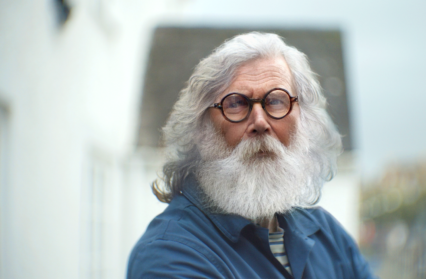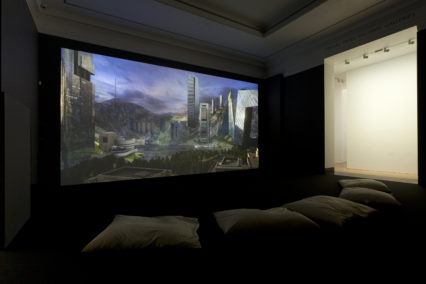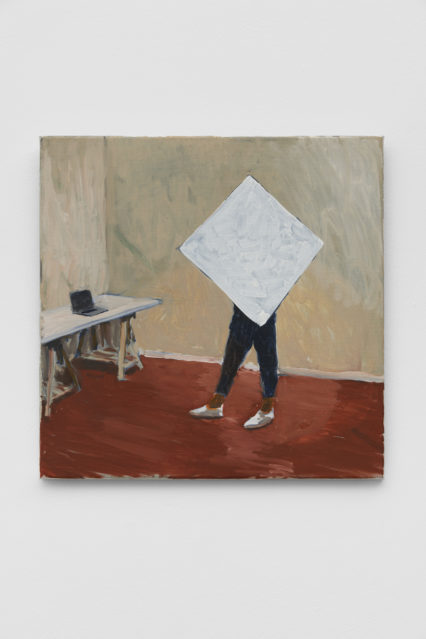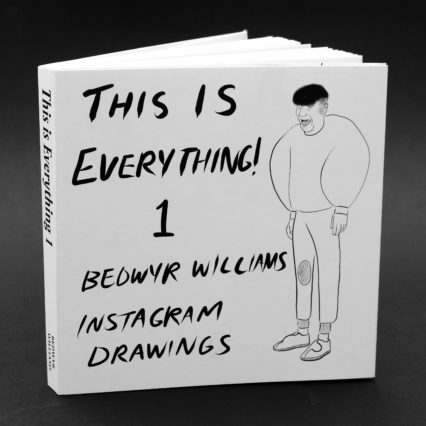Gary Raymond caught up with Bedwyr Williams to hear more about the inspiration and curation of his latest public art commission, ‘Do the Little Things’, a piece which connects the Welsh city of St David’s with the Irish town Ferns via a functional piece of art intended to be experienced and maintained by both communities.
Gary Raymond: So, we’re going to begin by talking about the commission (Do the Little Things). How did the new commission begin?
Bedwyr Williams: So, I was approached by the Contemporary Arts Society and they told me about this project called Ancient Connections, and one of their commissions that was coming live, or had just come live at that point, to create two public art works; one here in Saint Davids, Pembrokeshire, and one in Ferns, County Wexford in Ireland. There was a whole sheath of background history and archaeology, and I mean almost too much for my poor little arty brain, I didn’t know where to start. One of the other things that I had to kind of ruminate over was that both of these sites, particularly Saint David’s, have a lot of very important archaeology that couldn’t be disturbed. So, I was trying to think of an idea of what artwork could exist here in Saint David’s and in County Wexford that didn’t disturb the grounds in any way. So it couldn’t have any footings, or a subbase, or a foundation.
Gary Raymond: You couldn’t dig anything up or put anything in?
Bedwyr Williams: No, nothing, and it was almost like one of those puzzles that they put in the newspapers to recruit spy or like, codebreakers; I couldn’t fathom how I could make this work. And, also, because it was a shortlisting process, I quite enjoyed hearing the other artists squeal with how they were going to deal with it as well, and I knew some of them.
I knew a lot about Dewi Sant, you know, from school. I’m trying to think about the thing about the ground rising above his feet, but then I kept thinking of ideas that were really good for Saint David’s, but then not so good for Ferns in Wexford.
Gary Raymond: It seems like you had, sort of, a number of unique challenges. You had these two sites and you had restrictions on both sites, but they were quite different as well.
Bedwyr Williams: Exactly. So, it had to have a light footprint but join two places that had a sea in between them, without actually joining, of course. I thought about things to do with the Mabinogi, because their tales of feasts going awry between the Welsh and the Irish, but that didn’t fit in in Saint David’s or County Wexford. And then, I realised that the thing had to have legs and stand up, and not be stuck to the ground, so I thought about a temporary structure, not something made out of stone or metal. And then I read about the fact that Saint Aidan lived in Saint David’s, obviously it wasn’t called Saint David’s then, at least I doubt it was. I read Saint Aidan has tended the bees here and that he used to write in the fields, so obviously an outdoorsy chap. And then when he decided to leave and return to Ireland, the bees followed him to the ship three times, and on the third time Saint David realised that he had a real love and care for the bees [and let him take them]. So, the bees went to Ireland. Who knows if that’s true, but it’s great.
Gary Raymond: It seems to me that you were searching around for that little hook to spark the creative element of your project, that you’ve stumbled upon something that was there waiting to be discovered. There is part of that story, however mythologised it’s become, that is an actual real tangible connection with Ireland. You haven’t had to force anything that isn’t there.
Bedwyr Williams: No, you see when I read this thing, and it was on a strange website that looked like a website from the 90s, you know, with slightly pixelated graphics, and I was thinking ‘has anybody else seen this?’, and I was convinced then that the other artists on the short list would have seen this same story and they’d be on it. So, I got into real lockdown mode, and actually I think we were in lockdown, and it’s almost like I had to whisper my idea to the Contemporary Arts Society. So, I then thought just having beehives wouldn’t be interesting, and I was looking at mediaeval depictions of beehives, they were often in monasteries or cathedrals, and I found that often there would be little niches in the architecture, but, you know as somebody that born in 1974, my understanding of a bee skep is something that I’ve seen in a cartoon, or a honey container that is kind of nodding towards that form, in terms of its shape.
Gary Raymond: So how much research did you do into how the skeps work and why they are no longer used?
Bedwyr Williams: Well, enough research to find out they get destroyed every time you open them up. So, I thought, well that’s a nonstarter, you know, like a public artwork that is ruined every time the honey is harvested. I liked the fact that the skeps had a purpose, but to our eyes as well, they seem visually interesting. There are some things that are parts of our working lives that just happen to look really interesting. You know, like a chef’s hat. Chef’s wear quite boring clothes, but that tall hat is quite interesting. There are other examples but some things just have an aesthetic that is beyond their purpose, and I felt that these skeps had that. For whatever reason they were made in that shape, something about that has created a strong image. Obviously it’s a strong image because Gale’s honey, or whatever it is, Rowse, still uses it as a shape for their honey. So I thought, okay great, and then it occurred to me that we could fabricate an outer skep out of C&C technology. I wanted the rounds to be perfect, almost like a Disney cartoon so that I wasn’t going for some super authenticity, I wanted them to be slightly surreal, maybe, but with an allusion to something that was real. And inside these things, because they’re hollow, almost like russian dolls they come apart in three sections, like a Walnut Whip when you bite the top off, is maybe a good comparison.
Gary Raymond: So that’s how you eat a Walnut Whip, you bite the walnut off?
Bedwyr Williams: Yeah, I shouldn’t have told you, you probably think I’m immoral now.
Gary Raymond: Can you talk a little bit about why you’re having something that’s not got the authentic look, and having something removed from that?
Bedwyr Williams: I think I’m quite interested when you can’t quite fathom something straight away. You know, and also, I thought, by machining them, rather than by making them out of straw by hand, that I was maybe having a bit of a joke about more sculptural forms. So, you know, there’s like a kind of formality to these things by making them identical on numbers, six of them. And the table as well, that was a detail and all of those mediaeval kinds of depictions that were interested in the table, you know, it’s a platform and most people won’t know exactly what they are. And they could be something from outer space, they could be large versions of smaller things, or maybe like bobbins that have been made bigger.
Gary Raymond: So it’s that kind of, on first look, confusion. That feeling of ‘what am I actually looking at?’
Bedwyr Williams: Yeah, because they’re oversized. The thing that I haven’t mentioned, the big buzzy elephant in the room, is that they will have real beehives inside. So, there will be national hives inside.
Gary Raymond: So, they aren’t going to be working, operating skeps but they will have hives inside?
Bedwyr Williams: The hives will be operating inside, yes. And then in Ferns in Wexford, we’ve been able to find a similar kind of close location to the cathedral, so it’s perfect. Some of the locations that I was offered were slightly compromised. They felt like they were too far away from the main focus of interest in Saint Davids and then this site was suggested first and I came to see it in torrential rain last year or the beginning of this year. And I couldn’t believe that that was a potential goer for this site. So I said yes, yes, yes, please, can we have this? And then recently, I went to Ferns and we secured a similar site, similar in a way with all of the trees shaping around the skeps. So, I’m really happy about that.
Gary Raymond: So the actual location where both works of art would be, didn’t influence the evolution of the work itself?
Bedwyr Williams: No, I mean, the sites came later. I’ve made a few different iterations where the beehives are in slightly different places. One of the things about the locations as well is, you know, heaven forbid, something happens that means that we can’t keep them here, because they’re made out of wood and they’re basically big tables that are sitting on the ground, they can be picked up and moved. If there was some, I don’t know, act of God or something that would change the situation on the ground in Ireland or here in Wales. Sometimes the restrictions that are placed on you in terms of brief, are actually quite useful, being told what you can’t do forces you to hone in on what you can do.
Gary Raymond: I was interested in the fact that the nature of the project means that it’s reaching across from Ireland to Wales, but also there’s a reach because of the direction you’ve taken. There’s a reach back into history and so there are many dynamics to the directions you’re sort of working in. I like the fact that the whole idea is about being at the centre of a community. Do you want to talk a little bit more about the idea that, originally, they would have been part of the community and do you intend for them to be now?
Bedwyr Williams: Yeah, so, when I was reading about Saint Aidan tending the bees, I read that the honey was used for people that were in the cathedral and visiting and people in the immediate surroundings as well. That was important when I was developing the idea with the Contemporary Arts Society, that, you know, I know there’s a beekeeping scene here in Saint Davids, and strangely enough in Ferns as well. So it almost makes you think that these things have always been going on, it’s just that the focus wasn’t in these two sites anymore and all this project is doing, in a way, is I’ve come up with a clever idea about how it’s housed, but actually, I’m just tapping into networks that are already there and the expertise we’re getting from people here in Pembrokeshire, and people in Wexford. For instance, Joe, one of the beekeepers in Ferns, told me that you want to be making sure that rodents don’t get into the hives. And I said – well, I didn’t ask why, I mean, I’m sure you don’t want them in your hives – but I said what happens if they do get in and he said that the bees will kill the mouse and then they’ll cover it in wax so that it doesn’t pollute their hive. So they’re almost like these little serial killers that are like, you know, rolling their victims up in wax. He said that the bees can’t get rid of the mouse, you see, so they have to just wrap it in wax.
Gary Raymond: I’m seeing a twinkle in your eye now, that you’re thinking that this could be your next work.
Bedwyr Williams: Well, it’s what the people of Saint Davids can do to me if this project doesn’t work out.
So, you know, at heart, this is a really simple idea. It’s not a big thinky, you know, super clever idea. It’s just, I stumbled upon a story or an account, and I like stories – you know, that’s a pretentious thing “I like stories” – but I do like when somebody says “Oh, such and such used to live there and they did this” or, “blah, blah, blah used to work there”. You know, for example, my father told me about a guy in the village where he grew up who had an operation on his back, which meant that he had to ride his motorcycle standing up for six months to go to work. It’s a non-story, but I love things like that. Imagining the kids waiting to go to school and they just see this mannequin on a bike. It’s a scrap of a story and it’s the same with this. Who knows what the reality was with Saint Aidan, and it could be a bit of a story, you know, about the bees following him to the ship and how these things are embroidered and fermented over the years to become a story.
Gary Raymond: But there’s something, sort of like a thread, throughout all of your work which is about story, isn’t it? You’re really interested in narrative and clearly what attracted you to excavate these ideas was a story. We were talking a couple of days ago, just knocking some ideas around, this idea which hadn’t occurred to me before, that there is a small chance that the bees that are in these skeps could be descendants of Saint David’s bees.
Bedwyr Williams: Yeah, a very small chance, through marriage.
Gary Raymond: Yeah, distant cousins. But, there is enough of a chance to give a little bit more richness to the whole idea of it.
Bedwyr Williams: Yeah, part of it is in the world of absolute conjecture and nonsense, but then it is based on an account. I think that’s the thing about being an artist is you have licence to improvise a bit. I always think when you see strange customs, like folk customs, like Morris dancing or something, I think when did that become weird? Did they think when they did the first Morris dancing ‘let’s do a weird dance’, or did it start off quite silly and become weird like there was a misunderstanding? When do those things cross over into strange traditions where you’re not sure where they came from?
Gary Raymond: You have a long standing natural curiosity about Welsh history and the history of art, and obviously everybody would be familiar with your take on the Bard and the famous painting, but youre known for having a certain approach to subjects, which is a little bit different.
Bedwyr Williams: Yeah, I’m quite a sarcastic artist and a bit reactive. For instance, I’ve been making a film about myself as an older artist. So, I used AI technology to make myself look older, wearing one of those old blue French fisherman’s jackets. I’ve been using Instagram, during lockdown especially, to make light of other artists.
Gary Raymond: I’ve been doing the Review Show for Radio Wales for five years and it’s the only Instagram account we’ve reviewed as a piece of art because the whole thing, at least for a number of years now, is once continuous conceptual work in itself. It’s not just a place, like many artists do, to showcase work you’re working on.
Bedwyr Williams: Yeah, it’s another outlet or something. I love being an artist, don’t get me wrong, but there’s a lot of guff with it, as well, like how we dress and how we behave and the tantrums and the lovey-ness of it. Being brought up going to a Welsh Methodist chapel, I’m not a foppish person in any way. I’m from a farming background and when I told my uncles, the one that smelled of poo, that I was becoming an artist I might as well have told them I was becoming a clown or something, it’s that silly. I’ve always had that kind of irreverent attitude towards the art world and wanting to puncture some of the pomposity of it, I suppose.
View this post on Instagram
Gary Raymond: I think it speaks a lot of your attitude, but also your respect for the art work and the artworld that is punctuated with these brilliant satirical, sarcastic moments. I remember when we reviewed the Instagram account on the show, we talked quite a bit about how interesting it was that you’ve actually got an exhibit and a book out of skewering the art world on your instagram account, which has a great sort of irony to it.
Bedwyr Williams: Yeah, I mean, I’m an artist that’s decided to live in north Wales where I grew up. Most artists move to London or something, but I’ve always thought “Imagine if all the dentists moved to Berlin, what would happen to the rest of us?” Actually, I remember once going to the Art Fair in Basel, and it’s a big week long event for millionaires to fly in and buy artwork, and I was in a taxi from the airport and I said “this must be quite a wild time for you, with the art fair” and he [the taxi driver] said “no, the dentist export is a much wilder event.”
Gary Raymond: Coming back to the idea of storytelling, the one thing that comes across in the Instagram account is that there is this dedication to storytelling, there are recurring characters, and that’s something that’s quite important to your storytelling as well.
Bedwyr Williams: I’ve been thinking about being an artist since my late teens, and it’s my thing and I’ve devoted my life to it, but at the same time I think it’s important when somebody, a member of the public, going to see you’re work or encounters it, that there’s something that they can hook onto. I really don’t have much time for art that I kind of call ‘spy art’, where it’s like a riddle, a completely oblique gesture. Like doing Wordle and you get them all wrong, and you don’t know what it is then. I think even if your work has a lot of different denser layers that are more oblique, there should always be some level of generosity to your audience so that people can either have a bit of a laugh, or make them a bit sad, but there’s something there. If it’s a climbing wall you have to leave one of those little climbing things there so you can grab at it, because if they’re all up there, it’s not fair, is it? A lot of art work is funded, either from lottery or public purse, so I think you have to have some level of generosity to the public. Doesn’t mean the work has to dumb down or anything. I think narrative allows you to do that as an artist, that everyone can follow a linear narrative, to a degree. They can still say it’s boring and rubbish at the end, but there’s no ‘riddle me this, riddle me that’.
Gary Raymond: And [with the hives] they’re meant to be operational, but there meant to be community projects too. It’s meant for the people of Saint David’s to get involved.
Bedwyr Williams: Yeah, so that’s something we’re working with local beekeepers on. So, that’s why it’s interesting because the beekeepers in Ireland have a slightly different way of doing things, not very different but, apparently bee rustling is a big problem in Ireland, and not a problem here. People would leave an empty hive nearby and apparently lemongrass essential oil, if you put some of that on it, they go crazy, it’s like their catnip, and they’ll go there and inhabit that hive, and the rustler just takes it away. The Irish beekeeper told me that sometimes those people will sell the stolen bees back to the people who they stole them from. So it’s been interesting finding out about those differences. Some small differences in how they use the hives, but they both use natural hives in this instance. There was some concern here in Pembrokeshire about angry bees, and then in Ireland that was not a problem. There were things that I didn’t know as well, like there’s parts of the season where they gather pollen from ivy, and that apparently makes really bitter honey that you can’t eat.
Gary Raymond: So, you’ve had to sort of absorb all this and consider all of this?
Bedwyr Williams: Yeah, I knew nothing. I’m interested now and I know a lot more. But often it’s a case when you come up with an idea that you have to find people that do know what they’re talking about. There’s so many things about making sure the platform they sit on doesn’t wobble, because if it wobbles too much it disturbs the bees, which is what someone mentioned in Wexford.
Gary Raymond: Did you think about the ecological connotations of a project that has bees at the centre of it, because there are documents and books written about bees and their importance.
Bedwyr Williams: Yeah, I mean I thought I struck gold with that. One of the beekeepers said “actually there’s not a shortage of honey bees, it’s bumblebees that we’re short of ” and I thought “oh forget it”, you know? I was trying my best to come up with a winner. But I think we’re also looking into the planting of wildflowers around the hives as well, so that inadvertently does help part of the pollinators as well, we’re going in the right direction.
Gary Raymond: I was going to ask about the title of the piece, too [Do the Little Things].
Bedwyr Williams: Yeah, gwneud y pethau bychain, ‘do the little things’, I’ve heard that used so many times for so many different things. So, I’m actually working on a project with a science museum at the moment, and I’ve called that ‘Science Fictions’, and I thought that wasn’t very good. So, I’ve got projects at the moment with not very original titles. But, I think if it’s right, it’s right, so be it. I’ll just eclipse the other projects that have used this as their title, if I can.
This interview has been edited and condensed for clarity. You can find out more about Bedwyr Williams’ public art commission, Do the Little Things, here.






 Enjoyed this article? Support our writers directly by buying them a coffee and clicking this link.
Enjoyed this article? Support our writers directly by buying them a coffee and clicking this link.








